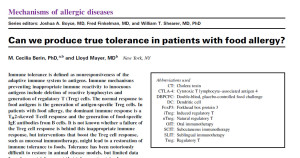 Abstract: “Immune tolerance is defined as nonresponsiveness of the adaptive immune system to antigens. Immune mechanisms preventing inappropriate immune reactivity to innocuous antigens include deletion of reactive lymphocytes and generation of regulatory T (Treg) cells. The normal response to food antigens is the generation of antigen-specific Treg cells. In patients with food allergy, the dominant immune response is a TH2-skewed T-cell response and the generation of food-specific IgE antibodies from B cells.
Abstract: “Immune tolerance is defined as nonresponsiveness of the adaptive immune system to antigens. Immune mechanisms preventing inappropriate immune reactivity to innocuous antigens include deletion of reactive lymphocytes and generation of regulatory T (Treg) cells. The normal response to food antigens is the generation of antigen-specific Treg cells. In patients with food allergy, the dominant immune response is a TH2-skewed T-cell response and the generation of food-specific IgE antibodies from B cells.
It is not known whether a failure of the Treg cell response is behind this inappropriate immune response, but interventions that boost the Treg cell response, such as mucosal immunotherapy, might lead to a restoration of immune tolerance to foods. Tolerance has been notoriously difficult to restore in animal disease models, but limited data from human trials suggest that tolerance (sustained nonresponsiveness) can be re-established in a subset of patients. Furthermore, studies on the natural history of food allergy indicate that spontaneous development of tolerance to foods over time is not uncommon. The current challenge is to understand the mechanisms responsible for restoration of natural or induced tolerance so that interventions can be developed to more successfully induce tolerance in the majority of patients with food allergy.”
Conclusions: “The natural history of food allergy indicates that such allergy can be outgrown and therefore shows that it is possible to acquire tolerance after sensitization has occurred. Unfortunately, natural tolerance is infrequent for antigens such as peanut, tree nuts, fish, or shellfish. Two placebo-controlled trials have been performed that directly address tolerance in response to OIT, one showing no beneficial effect of OIT on tolerance and the other showing tolerance induction in a minority of subjects with egg allergy.
Although the latter study shows promise, these findings need to be verified through repetition and expanded to other food allergens. The data do not yet support the use of OIT as a therapy to induce immune tolerance. However, by carefully profiling immune tolerance when it has been successfully established either through natural outgrowth or experimental intervention, we expect to identify means of establishing tolerance in the remaining majority of patients with food allergy. ”
http://www.jacionline.org/article/S0091-6749(12)01837-4/fulltextRead article here: Can we produce true tolerance in patients with food allergy?
Thanks to Dr. Chad Mayer for explaining this publication in terms we can understand:
 “The majority of the article was an in depth review of the immunologic changes we possibly undergo when we develop tolerance to something. Remember desensitization is the state of not reacting to a substance while regularly being to exposed to the allergen, tolerance is the state of not reacting to the allergen when regular exposure is discontinued. This article when boiled down first shows we still do not know how to fully measure tolerance (we do not know what to measure). Second it shows no study has shown permanent tolerance introduced by OIT.
“The majority of the article was an in depth review of the immunologic changes we possibly undergo when we develop tolerance to something. Remember desensitization is the state of not reacting to a substance while regularly being to exposed to the allergen, tolerance is the state of not reacting to the allergen when regular exposure is discontinued. This article when boiled down first shows we still do not know how to fully measure tolerance (we do not know what to measure). Second it shows no study has shown permanent tolerance introduced by OIT.
I refute the conclusion that OIT is not ready because we do not know it it induces tolerance. First, we just celebrated the 100th year of subcutaneous allergy injections for the treatment of aeroallergens. During this 100 years we have known that over time some people will gain long term tolerance some tolerance for a few years and some wont develop tolerance but will be desensitized. So, in short for 100 years we have treated patients made them feel better but have not “cured” them. It is hard not to make similar parallels to OIT. Treat and make patients feel better, protect them and then try to figure out if tolerance is imparted.
A major flaw in this review is:
1. The lack of acknowledgement that we just do not understand as of yet what to measure for tolerance.
2. Studies on the development of tolerance with OIT are flawed and incomplete. We have known for decades that patients receiving subcutaneous injections for allergies must receive the injections for at least 3-5 years before there is possibility of imparting tolerance.
So, tell me why are all tolerance studies looking for tolerance at 1 year or 2 years of therapy and over these last 10 years of the modern studies none have looked ate patients treated for longer periods of time?
The conclusion in this article is correct… “the data do not yet support the use of OIT as a therapy to induce immune tolerance.” This article’s goal was not to address the impact of desensitization or the procedure of desensitization.”